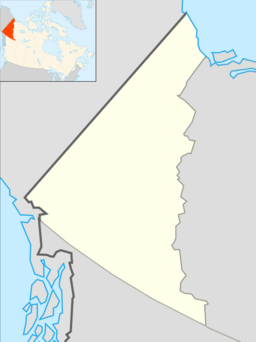Kusawa Lake facts for kids
Quick facts for kids Kusawa Lake |
|
|---|---|
| Location | Yukon (Canada) |
| Coordinates | 60°21′22.7″N 136°20′25.9″W / 60.356306°N 136.340528°W |
| Primary inflows | Takhini River, Primrose River, Kusawa River |
| Primary outflows | Takhini River |
| Basin countries | Canada |
| Max. length | 75 km (47 mi) |
| Max. width | 2.5 km (1.6 mi) |
| Max. depth | 140 m (460 ft) |
| Surface elevation | 671 mi (1,080 km) |
| Settlements | Whitehorse, Yukon |
Kusawa Lake is a beautiful lake in the southern Yukon, Canada. Its name, Kusawa, comes from the Tlingit language. It means "long narrow lake." This name perfectly describes the lake's shape!
Kusawa Lake is about 60 km (37 mi) southwest of Whitehorse, near the border with British Columbia. It sits high up, at an altitude of 671 m (2,201 ft). The lake stretches for about 75 km (47 mi) and is about 2.5 km (1.6 mi) wide at its widest point.
The lake gets its water from rivers like the Primrose River and Kusawa River. The Takhini River flows out of Kusawa Lake's northern end and eventually joins the Yukon River. Kusawa Lake covers an area of 142 km2 (55 sq mi). It is very deep, reaching 140 m (460 ft) at its deepest point. The lake was formed by glaciers long ago. It is a popular spot for tourists and for fishing.
Contents
Discovering Kusawa Lake's Features
Kusawa Lake is one of many large, long, and narrow lakes in the southern Yukon. These lakes were all formed by glaciers. Most of them are part of the big Yukon River system. Other lakes like this include Teslin Lake, Atlin Lake, Tagish Lake, Marsh Lake, Lake Laberge, and Kluane Lake.
You can reach Kusawa Lake by an unpaved road. This road branches off from the Alaska Highway, which is about 20 km (12 mi) north of the lake.
Understanding the Name Kusawa
The name Kusawa comes from a phrase in the Tlingit language. It means "narrow lake." Long ago, when glaciers melted, they often left behind long and narrow lakes. Because of this, at least four lakes were once called Kusawa. Today, only this one keeps the name.
Exploring Ancient History at Kusawa Lake
About 6 km (3.7 mi) east of the campgrounds at Kusawa Lake, archaeologists made an important discovery. In 1997, they found the first of the Yukon Ice Patches on a mountain called Thandlät.
These Yukon Ice Patches are special places where ancient items are preserved in the ice. Archaeologists work with six First Nations groups from the Yukon to study these patches. The First Nations include the Carcross/Tagish First Nation, the Kwanlin Dün First Nation, the Ta’an Kwäch’än Council, the Champagne and Aishihik First Nations, the Kluane First Nation, and the Teslin Tlingit Council.
One amazing find was a piece of a wooden dart shaft. Scientists used radiocarbon dating to find out how old it was. They learned it was about 4,360 years old!
Kusawa Lake Territorial Park: A Protected Area
The Kusawa Lake Territorial Park is a large protected area. It covers about 3,082 km2 (1,190 sq mi). This park is currently being planned to help protect the natural environment around the lake.
Wildlife of Kusawa Lake
Fish Species in the Lake
The waters of Kusawa Lake are home to several types of fish. The most common fish you might find include Arctic grayling, herring, Round whitefish, and American char.
Caribou in the Region
Today, there are no longer any caribou living in the Kusawa Lake area. However, old stories tell us that caribou used to be everywhere here. An Elder named Mary Ned, who was born in the 1890s, spoke about caribou being "all over this place" in her interviews from 1987.
The ancient items found in the Ice Patches, like the dart shaft, also show that caribou were once common. Oral history also mentions a caribou fence or corral. This was located on the east side of the lake, between the lake and the mountain.


